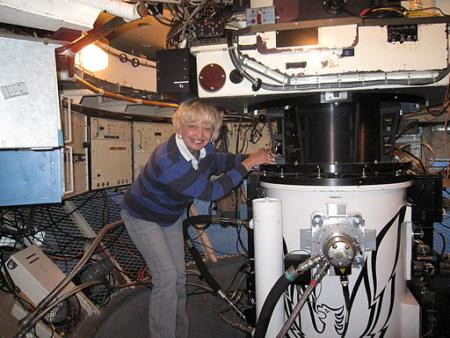Cue the music! We invite you to our third "She Blinded Me with Science" Women in Science Wikipdia Edit-a-thon III.
As was the case for the last two edit-a-thons, you can participate both in-person at the Archives, and on-line by joining us in a Google Hangout and etherpad (links to come on the event page linked above.) By participating, you will receive a tour of the Archives, a talk on popular media's role in the history of women in science, an introduction for beginners on editing in Wikipedia, coffee & lunch (if you join us in-person,) and the satisfaction of writing a female scientist into digital history.
In years past, we have focused on women in the history of science which has resulted in the creation of more than 50 new articles on groundbreaking geologists, anthropologists, botanists and more. Let's take a look at some of these women:
Ursula B. Marvin, planetary geologist from the Harvard-Smithsonian’s Astrophysical Observatory, won several awards for her research (1997 Lifetime Achievement Award from Women in Science and Engineering, 1986 History of Geology Award from the Geological Society of America, and the 2005 Sue Tyler Friedman Medal), and had an Antarctic mountain named after her.

Ornithologist Roxie Laybourne basically founded the field of forensic ornithology. Laybourne was very interested in aeronautics and even took an aeronautics correspondence course after not being able to attend aviation school because she was female. She used the Smithsonian's vast bird collection and scanning electron microscopy to identify birds involved in plane crashes. She helped to improve air travel safety working in conjunction with the Federal Aviation Administration and the National Transportation Safety Board.

For this year, we have added 35 more female scientists to our to-do list. Some of them were uncovered by our digital volunteers while transcribing scientific field books in the Smithsonian's Transcription Center. The list also contains many current female scientists at the Smithsonian who are working on everything from the conservation of wild canids to high-energy astrophysics. Join us in writing these women into digital history.

Related Resources:
- Sign up for the "She Blinded Me with Science III," Women in Science Wikipedia Edit-a-thon III, Friday, March 27.
- Roxie Collie Laybourne: Remembering a Groundbreaker, Bigger Picture Blog
- Documenting a Geologist's Adventures, Bigger Picture Blog
- Women in Science Wednesdays, Bigger Picture Blog
Related Collections
- Science Service Records at the Smithsonian Institution Archives
Produced by the Smithsonian Institution Archives. For copyright questions, please see the Terms of Use.

Leave a Comment